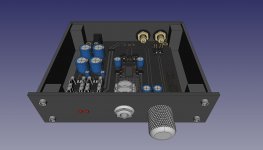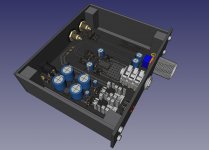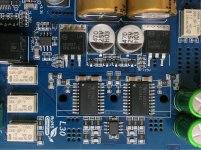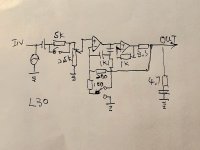Not really much progress with this project in terms of circuit changes.
10mΩ output impedance which I got with inductor outside feedback loop is better than enough. Didn't yet played with taking feedback at different point, other op amps or other tweaks.
This probably would yield even better performance. But first, I need something better than APx525 to examine those subtle changes.
However I tried to design some enclosure. It's not that ugly, especially considering that was first time I did mechanical design and used CAD software
I need to admit that KiCad is much more intuitive than FreeCAD. I guess commercial software like Inventor is much better in that field.
10mΩ output impedance which I got with inductor outside feedback loop is better than enough. Didn't yet played with taking feedback at different point, other op amps or other tweaks.
This probably would yield even better performance. But first, I need something better than APx525 to examine those subtle changes.
However I tried to design some enclosure. It's not that ugly, especially considering that was first time I did mechanical design and used CAD software
I need to admit that KiCad is much more intuitive than FreeCAD. I guess commercial software like Inventor is much better in that field.
Attachments
I still have few spare boards. But majority of parts are SMD and TPA6120A2 has bottom tab which is a bit hard to solder I don't think there will be much interest in DIY market.
Preparing kits and keeping them in stock, especially including cases would require freezing huge amount of money.
I considered offering this amp as commercial product and maybe pre-assembled PCB modules but that definitely not gonna happen too soon.
Preparing kits and keeping them in stock, especially including cases would require freezing huge amount of money.
I considered offering this amp as commercial product and maybe pre-assembled PCB modules but that definitely not gonna happen too soon.
Do you have a couple of boards for sale? I would like 2 or 3 thanksI still have few spare boards. But majority of parts are SMD and TPA6120A2 has bottom tab which is a bit hard to solder I don't think there will be much interest in DIY market.
Preparing kits and keeping them in stock, especially including cases would require freezing huge amount of money.
I considered offering this amp as commercial product and maybe pre-assembled PCB modules but that definitely not gonna happen too soon.
You might find this useful...
Which amp is this?
Sorry for late response. I was away at holidays and now I'm pretty busy as I just moved to another city.

Thanks for schematic. Topology is similar to my amplifier, yet feedback circuit is a bit more clever than mine. Topping L30 is new price/performance ratio kingYou might find this useful...
I still have 6 bare boards and two populated with SMD parts. Toss me PM or email if you're interested.Do you have a couple of boards for sale? I would like 2 or 3 thanks
TPA6120A2 is current-feedback amplifier. Compared to more popular VFA inverting input can't be connected directly output when used as a non inverting buffer. Value of feedback resistors sets closed loop bandwidth, instead of capacitor in feedback loop like in VFA. But that's right, I didn't seen that topology often.Topping L30, as evident from the "L30" silkscreen. The feedback network in the inner loop is interesting, I haven't seen that exact arrangement before.
it looks like tpa6120 being used in unity gain which lowers the slew rate significantly and probably it makes it more stable.Yet we know nothing abot any possible components on the bottom layer....Topping L30, as evident from the "L30" silkscreen. The feedback network in the inner loop is interesting, I haven't seen that exact arrangement before.
Last edited:
There is more discussion about the topology here:
Topping L30 Headphone Amplifier Review | Page 34 | Audio Science Review (ASR) Forum
And also page 35
Topping L30 Headphone Amplifier Review | Page 34 | Audio Science Review (ASR) Forum
And also page 35
I just bought the L30 to use as a linestage / preamp to drive my F4 or one of many tube amps. It is the cleanest line stage I have ever heard (I have a pile of line stages I’ve built over many years) My source is normally one of two tube dacs.
The soundstage presentation is deep, wide and smooth. I would say that it certainly is the proverbial “wire with gain” stage, but not quite. It’s a bit smoother then other things that I’ve built that do not have much of a sonic signature. The L30’s measured performance borders on the the absurd.
The headphone section, with its crummy monolithic opamp I would call very good to excellent. It begs to be modded.
The L30 is a very good place to start with his feedback scheme and better house keeping supplies via discrete regs this could be the end of the performance line. The TPA’s input buffer needs a discrete as well.
I would urge everyone here to grab one of these and spend some time with it.
Good work and keep going!
Cheers,
Greg
The soundstage presentation is deep, wide and smooth. I would say that it certainly is the proverbial “wire with gain” stage, but not quite. It’s a bit smoother then other things that I’ve built that do not have much of a sonic signature. The L30’s measured performance borders on the the absurd.
The headphone section, with its crummy monolithic opamp I would call very good to excellent. It begs to be modded.
The L30 is a very good place to start with his feedback scheme and better house keeping supplies via discrete regs this could be the end of the performance line. The TPA’s input buffer needs a discrete as well.
I would urge everyone here to grab one of these and spend some time with it.
Good work and keep going!
Cheers,
Greg
I don't think composite amplifiers with high-speed OpAmps are very suitable for modifications, unless you know what you are doing and have the necessary tools to observe how modifications impact performance as well as stability of the amplifier. The TPAs "input buffer" is the VFA that performs error correction on the output buffer. It has very low input voltage noise and as much open loop gain throughout the audio band as you can get with unity gain stable dual IC-OpAmps.
Kn0ppers,
Yes, differing device means differing bias current vs common-mode voltage, which would change the distortion profile. So, you try different devices and measure. But, for me, I simply don’t care for monolithic OPAs. He’s optimized the distortion for the OPA1612 into the TPA6120A2 for lowest distortion and that’s not what I’m about.
Generating higher levels of H2 would be fun. My workshop is for fun and not to produce a product.
Cheers,
Greg
Yes, differing device means differing bias current vs common-mode voltage, which would change the distortion profile. So, you try different devices and measure. But, for me, I simply don’t care for monolithic OPAs. He’s optimized the distortion for the OPA1612 into the TPA6120A2 for lowest distortion and that’s not what I’m about.
Generating higher levels of H2 would be fun. My workshop is for fun and not to produce a product.
Cheers,
Greg
You can think of the 6120 as the “muscle” for any preamp you have in mind. If configured for SE input per the factory data sheet it is unity gain and stable into just about any load.
So have fun, try tube preamps, or the whole assortment of any other other type of preamp that might be SE Class A.
The 6120 will be transparent and simply drive any headphone load with the desired input characteristics of the preamp.
So have fun, try tube preamps, or the whole assortment of any other other type of preamp that might be SE Class A.
The 6120 will be transparent and simply drive any headphone load with the desired input characteristics of the preamp.
- Home
- Amplifiers
- Headphone Systems
- High performance OPA1602 + TPA6120A2 Composite Headphone Amplifier



